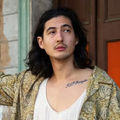FIT Museum to explore queer history of fashion
Opening on September 13, 2013, A Queer History of Fashion will feature approximately 100 ensembles, from 18th-century menswear styles associated with an emerging gay subculture to 21st-century high fashion.
From Christian Dior to Yves Saint Laurent to Alexander McQueen, the importance of gay men as fashion designers is undeniable in the 20th century. But scholars have demonstrated that, as early as the 1700s, men who loved other men were pioneers in challenging sex and gender roles.
Drawing on this research, A Queer History of Fashion: From the Closet to the Catwalk will be organized chronologically, beginning with the 18th century, when cross-dressing “mollies,” foppish “macaronis,” and “men milliners” created controversy.
Exhibition curators Fred Dennis, senior curator of costume, and Valerie Steele, director and chief curator of The Museum at FIT, spent two years researching and curating the exhibition. They worked with an advisory committee of eminent scholars, including professors George Chauncey (author of Gay New York), Shaun Cole (author of Don We Now Our Gay Apparel), Jonathan Katz (author/curator of Hide and Seek), Peter McNeil (co-editor of The Men’s Fashion Reader), and Vicki Karaminas (co-editor of the forthcoming Queer Style), as well as FIT faculty and fashion professionals.
“This is about honoring the gay and lesbian designers of the past and present,” said Dennis. “By acknowledging their contributions to fashion, we want to encourage people to embrace diversity.”
“We also hope that this exhibition will transform our understanding of fashion history,” added Steele. “For many years, gays and lesbians were hidden from history. By acknowledging the historic influence of gay designers, and by emphasizing the important role that fashion and style have played within the LGBTQ community, we see how central gay culture has been to the creation of modern fashion.”
Oscar Wilde was a key 19th-century figure with regard to both the history of homosexuality and the history of style. Known for his influence on aesthetic dress, Wilde was also identified with a flashy sort of dandyism associated with the most visible urban homosexuals.
Although it has not been possible to find clothing actually worn by Wilde or other gay men and lesbians from this period, styles similar to what they wore will be on display.
Elite menswear looks became an important stylistic signifier for lesbians in the late 19th and early 20th centuries. The garçonne look of the 1920s brought lesbian style into high fashion.
Several extraordinary menswear looks worn from the 1930s on by the great bisexual actress Marlene Dietrich have been made available for this exhibition by the Berlin Film Museum. Also featured will be Yves Saint Laurent’s iconic Le Smoking, which was inspired by Dietrich’s tuxedo.
Click here to read full details
Fashion Institute of Technology
































-Ltd..jpg?tr=w-120,h-60,c-at_max,cm-pad_resize,bg-ffffff)





.jpg?tr=w-120,h-60,c-at_max,cm-pad_resize,bg-ffffff)
.jpg?tr=w-120,h-60,c-at_max,cm-pad_resize,bg-ffffff)






